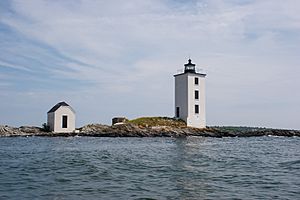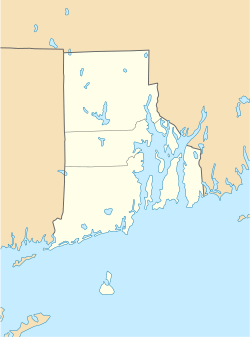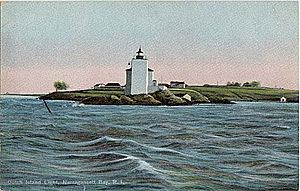Dutch Island Light facts for kids
 |
|
| Dutch Island light in 2009, viewed from a kayak | |
|
|
|
| Location | Jamestown, Rhode Island |
|---|---|
| Coordinates | 41°29′48.27″N 71°24′15.35″W / 41.4967417°N 71.4042639°W |
| Year first constructed | 1826 |
| Year first lit | 1857 |
| Automated | 1947 |
| Deactivated | 1979 - 2007 |
| Foundation | Surface rock |
| Construction | Brick |
| Tower shape | Square |
| Markings / pattern | White with black lantern |
| Focal height | 56 feet (17 m) |
| Original lens | 4th order Fresnel lens |
| Current lens | 9.8 inches (250 mm) |
| Characteristic | Flashing red 6 seconds |
| Fog signal | none |
| Admiralty number | J0621 |
| ARLHS number | USA-250 |
| USCG number | 1-19101 |
The Dutch Island Light is an old lighthouse on Dutch Island. This island is located near Jamestown, Rhode Island. The lighthouse helps guide boats safely through the west passage of Narragansett Bay. It also helps ships find their way into Dutch Island Harbor.
The U.S. government bought 6 acres of land on the island in 1825. The first lighthouse was built there in 1826. It was 30 feet tall and made from stones found right on the island. In 1857, a new, taller brick tower was built. It was 42 feet tall. A fog bell was added in 1878 to help boats in foggy weather.
Contents
History of Dutch Island
Dutch Island is in Narragansett Bay, between Jamestown and Saunderstown. The Narragansett people first called it "Quetenis." They sold it to the Dutch West India Company around 1636. The Dutch used the island as a safe place to trade with the Narragansett people. They exchanged goods for meat, fish, and furs. Later, English settlers used the island to let their sheep graze.
For many years, the island was important for defense. It had forts to protect the West Passage from attacks by sea. During the American Civil War, large stone structures were built for cannons. In the late 1800s, there were huge 15-inch Rodman guns on the island. These cannons could fire a 300-pound cannonball up to 3 miles!
Around the late 1890s, the Army built Fort Greble on Dutch Island. This fort had powerful long-range cannons. It could house almost 500 soldiers. Fort Greble was active until 1924. It was even used for training during World War II.
Building the Lighthouse
The first lighthouse tower was built in 1826. It was 30 feet tall. One of the first lighthouse keepers was Robert Dennis. He was 78 years old when he started. He stayed keeper until he was over 90! His son, also named Robert, took over after him.
People in the mid-1800s said the first lighthouse and keeper's house were "the worst construction of any in the state." The light itself was called "wretched." So, in 1857, the old tower and keeper's house were torn down. They were replaced with the brick tower you see today. This new tower was 42 feet tall. It cost $4,000 to build, which was a lot of money back then. It also got a new Fresnel lens that made the light brighter and more focused. In 1878, a fog bell was added. It worked with a clockwork system.
In 1924, the light was changed to a flashing red kerosene lamp. A local resident remembered that a "very big weight on pulleys" rotated the lens.
Lighthouse Keepers
Here are some of the people who kept the Dutch Island Light working:
- William Dennis (1827–1843)
- Robert H. Weeden (1843–1844)
- William P. Babcock (1844–1846)
- Robert Dennis (1846–1853)
- Benjamin Congdon (1853–1859)
- M. M. Trundy (1859–1865)
- Lewis T. King (Nov. 24, 1885 to Sept. 20, 1901)
John Paul was one of the last keepers, from 1929 to 1931. His son, Louis, remembered that his father grew vegetables and raised ducks. He said the fishing was "excellent" and his father would catch "a bushel of blackfish before breakfast."
Automation and Deactivation
In 1947, the lighthouse became automated. This meant it ran on electricity and didn't need a keeper anymore. The military left the island. In 1950, the keeper's house was torn down because of damage and vandalism.
In 1972, the Coast Guard thought about turning off the light completely. Many people wrote letters to protest this idea. So, the Coast Guard kept the light on and even made it brighter! But vandalism continued. In 1977, the light was finally turned off. In 1979, a flashing red buoy was placed near the island instead.
Dutch Island Lighthouse Society is Formed
In 2000, a group called the Dutch Island Lighthouse Society (DILS) was created. Their goal was to fix up the lighthouse and get its light working again.
In May 2000, experts visited the lighthouse. They found that the building was still very strong, even though it needed many repairs. They called it an "Historic Building."
In 2001, DILS asked for money to restore the lighthouse. The estimated cost was $120,000. It took seven more years to plan everything and get through all the paperwork. In January 2004, DILS became a non-profit organization. They raised money from big donors and many small donors.
In 2005, DILS signed a long-term lease for the lighthouse from the state. An engineering company helped create plans for the repairs. They wanted to make sure the work could be done within the $120,000 grant.
The plans had to be approved by many different groups. Finally, DILS could ask companies to bid on the restoration work. Abcore Restoration, a company known for restoring other lighthouses, won the bid. Work began on July 25, 2007.
Workers built a temporary landing area from old tires. They used a small boat with a hoist to bring all their tools and materials to the island. They fixed the outside of the tower, making it gleaming white. They also replaced the roof and the glass in the lantern room. The inside staircase and windows were repaired too. A small building nearby, called the "oil house," was also cleaned and fixed up.
On November 17, 2007, many people gathered to see the lighthouse relit. At 7:00 p.m., a cannon fired, and a founding member of DILS pushed a button. For the first time in 28 years, the Dutch Island Light was flashing red again!
Gallery






